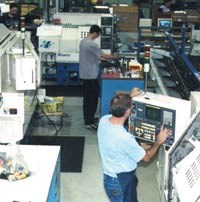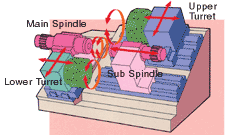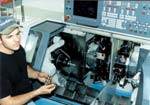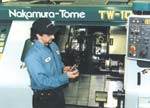Prototypes . . . And Then Some
Turn-mill machines have made this prototype shop competitive for large-volume orders too.
Share


When it comes to prototype parts, Schultes Precision Manufacturing, Buffalo Grove, Illinois, prides itself on providing a combination of price, delivery and quality that is hard to beat. Now, the firm is bringing that same competitiveness to large-volume runs (1,000 or more pieces) with the addition of four seven-axis turn-mill machines to its more conventional single-spindle CNC lathes and machining centers.
The need for the more sophisticated machines was clear: The shop had been doing production runs for 30 years or more, but several years ago it began losing business to other shops on jobs involving 500 pieces or more, according to Otto J. (O.J.) Schultes, president of the firm. Many of the jobs involved turned parts that required light to medium milling, drilling and so forth. The shop quoted them as machined in the conventional manner, that is, machined in several operations on several different pieces of equipment.
“We were losing the jobs because our quotes were too high,” Mr. Schultes explains. “Knowing our costs, I couldn’t believe some of the low prices that our customers were paying for jobs that we had quoted—as much as $3.00 less per part.”
Determined to improve his shop’s competitiveness, Mr. Schultes contacted Arthur Machinery, Inc. (Elk Grove Village, Illinois), the Chicago-area distributor for Miyano Machinery Inc. (Wood Dale, Illinois), a producer of CNC lathes and other CNC machine tools. Arthur Machinery showed him Miyano’s BNE line of CNC turn-mill machines capable of completely machining turned and milled parts in one setup and explained how the shop could use the two-turret, two-spindle machines to achieve faster cycle times on turned and milled parts.
Mr. Schultes provided some part prints—including some prints of jobs that he had lost—to Arthur Machinery and asked the distributor to run some time studies for the parts. When Mr. Schultes saw the results of the studies, he began to understand how his competitors were able to quote lower prices. The time studies convinced him to buy a BNE-34S, a turn-mill machine with a 1.34-inch-diameter bar capacity.
The BNE-34S is a slant bed lathe with a main spindle and a subspindle and upper and lower tool turrets (see diagram). This increasingly popular configuration allows a part to be held in the main spindle for machining of the front end, cut off from the bar, and then transferred to the sub-spindle for machining of the back end of the part.
The upper and lower tool turrets have 12 and ten tool stations respectively. In addition to turning tools, the upper turret can accommodate six live (rotating) tools and the lower turret five tools, enabling the machine to perform a full range of milling and drilling operations on the part in addition to turning operations. As a result, most parts can be completely machined in one setup, eliminating the need to move the part to other machine tools for secondary machining operations.
The BNE-34S is designed for use with a bar feeder. In Schultes Precision Manufacturing’s case, the machine is equipped with an IEMCA 12-foot, magazine-style bar feeder that allows the machine to be operated for long periods in an unattended mode.
Most of Schultes’ machine tools are capable of performing different machining operations, but they must perform those operations one at a time. What impressed Mr. Schultes most about the BNE-34S, with its two spindles and two turrets, is its ability to perform two different machining operations simultaneously, dramatically reducing the amount of time required to completely machine the part.
The upper turret can machine a part held in the main spindle while the lower turret machines a part in the subspindle, or vice versa. Also, both turrets can be used to simultaneously machine a part in either spindle. The ability to perform different machining operations at the same time—turning and facing, turning and drilling, and so forth—and to combine two tools, one from each turret, in the same cut creates opportunities to reduce part cycle time that are limited only by the imagination. For example, few process planners would consider the BNE-34S for shaft work, however bar can be supported between the main spindle and the subspindle—spindle speeds are coordinated by the CNC control—and OD turning operations on the shaft can be divided between the upper and lower turrets to slash cycle time.
The BNE-34S made such a difference to Schultes Precision Manufacturing’s ability to efficiently process medium- to large-quantity jobs that it purchased a second machine a few months later. Then, it purchased two more machines, this time BNE-51S turn-mill machines with a larger (2-inch) bar capacity.
The turn-mill machines are not used for every job: prototypes are still made on manual machine tools in the model shop and small runs (from tens to hundreds of pieces) are usually processed across the shop’s more conventional CNC machine tools. But where production quantities permit their use, “the turn-mill machines are the most cost-effective way to do the job,” insists Otto’s son, Ryan Schultes, the administrative manager for the shop and one of its two process planners. “When the job involves 1,000 or more pieces and combines intensive turning with light to medium milling, I usually schedule it to run on one of the BNEs,” he explains.
Cuts Cycle Times
“We have been able to reduce part cycle times by 25 percent to 50 percent by running the jobs on the turn-mill machines,” Otto Schultes says. “While the front end of the part is being machined in the main spindle, the back end of the previous part is being machined in the subspindle. Essentially, we’re getting the back end work for free.”
The job is completed in one setup on one machine. That eliminates the need to perform secondary operations on the parts, saving the hourly operating costs and labor costs required to run those secondary-operation machines. It also eliminates work-in-process since jobs are not parked at machines waiting for one or more operations needed to complete the parts.
Fewer Foul-ups
Another important advantage of the turn-mill machines for Schultes Precision Machining is that they minimize the opportunity for errors that comes with frequent part handling. For example, an operator can do a great job running the first half of a 1,000-piece run on a conventional CNC lathe, but when setting up to machine the opposite end of the part, there may be a chip in the collet, or the operator may fail to fully seat the parts, or a dozen other things could happen, to ruin the job. Because the part stays in the turn/mill machine, the shop minimizes the possibility of handling errors and other inconsistencies caused by human error.
Still another advantage of the turn-mill machines is their ability to run for long periods unattended. One operator can run two or three of the machines, which greatly reduces labor costs for the jobs that go across the machines. That does not mean that Schultes Precision Manufacturing has cut the size of its labor force. In fact, just the opposite has happened.
“When our operators saw the turn-mill machines coming in, some started worrying about being replaced by automation,” Mr. Schultes notes. “The machines don’t eliminate jobs, they create jobs because they increase the amount of work we can handle. We still need good operators. Investing in new equipment doesn’t eliminate good people, instead it gives them an opportunity to get ahead by stepping into more responsible positions.” In fact, over the last 5 years, during which time the firm acquired the turn-mill machines, the firm has grown from 60 employees to 110.
The four turn-mill machines are grouped, along with two Miyano LZ-01R self-loading turning centers, in a work area designed to permit them to be monitored by just a few employees. The shop has a number of fussy jobs, involving difficult-to-machine materials, which require close supervision by an operator. For that reason, the operator-to-machine ratio is higher during the day shift, when such jobs are usually run, than during the night shift when less demanding jobs are scheduled. In fact, less demanding jobs are scheduled to run during the night shift, when one operator usually has responsibility for monitoring three machines.
Free Machining Time
The shop runs two 10-hour shifts, 11-hour shifts when busy. “Where our more conventional machines become idle when the operator takes a break, goes to lunch or for whatever reason is away from the machine, our turn-mill machines and self-loading turning centers continue to operate during those times so that production is not interrupted,” Ryan Schultes points out. “The machines also continue to run during the 2 to 4 hours before the first shift, so we’re getting several hours of labor-free machining time.”
Schultes Precision Manufacturing will never abandon its roots as a prototype shop. However, the Miyano turn-mill machines have made the shop much more competitive when it comes to stepping up to production quantities of those parts. The firm has grown 15 to 20 percent annually over the last 5 years, and while Mr. Schultes will not attribute all of that growth to the turn-mill machines, he credits them with most of it. Currently, about 70 percent of the parts that the shop makes from bar are produced in one setup on the turn-mill machines.
“We’re getting many more orders involving 2,000 to 20,000 parts than we saw 3 years ago,” Ryan Schultes adds. “Having the turn/mill machines has allowed us to pursue large-quantity work—and to be more aggressive in pricing. We can quote jobs 20 to 25 percent below what we would have had to charge if we machined the parts the traditional way.”
Finished Parts Faster
Have the turn-mill machines helped the shop get through the current business downturn? “Right now, no one is ordering parts for stock,” reports Otto Schultes. “When customers call to order parts, they need them yesterday. If we were still processing volume jobs the conventional way, all of the parts would go through the first operation, then the second operation, and so on through the final operation, before we could ship anything. The turn-mill machines produce parts complete, however, so we can begin shipping limited quantities of parts as soon as we have the job up and running.
“In slow times, customers sharpen their pencils more,” Mr. Schultes adds. “We were having trouble staying competitive on large orders using conventional machines when times were good. Without the turn-mill machines, we’d be even less competitive today. With them, we’ve gotten more work from our major customers because we are able to produce larger part quantities faster—and at competitive prices.”
Related Content
Addressing Manufacturing Challenges with Automation
GrayMatter Robotics’ Physical AI robotic cells for manufacturing offer immediate impact and results.
Read MoreInside a CNC-Machined Gothic Monastery in Wyoming
An inside look into the Carmelite Monks of Wyoming, who are combining centuries-old Gothic architectural principles with modern CNC machining to build a monastery in the mountains of Wyoming.
Read MoreThe Future of High Feed Milling in Modern Manufacturing
Achieve higher metal removal rates and enhanced predictability with ISCAR’s advanced high-feed milling tools — optimized for today’s competitive global market.
Read MoreAdditive/Subtractive Hybrid CNC Machine Tools Continue to Make Gains (Includes Video)
The hybrid machine tool is an idea that continues to advance. Two important developments of recent years expand the possibilities for this platform.
Read MoreRead Next
Small Shop, Mighty Machines
Multitasking machines capable of completely machining complex, milled and turned parts in a single setup are powering this Chicago-area job shop's growth.
Read MoreProgramming Multi-Axis Lathes
You're going to need more than the CAM program you're currently using for your standard CNC lathes and mills.
Read More































